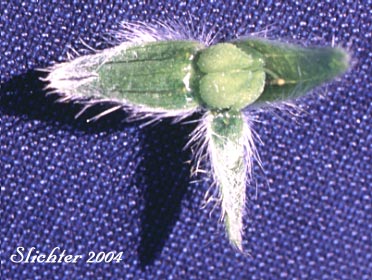 The
photos on this page illustrate tarweed fiddleneck. The photos were all taken on
the northwest side of Sutton Mt. several miles east of Priest Hole Boat Launch
(BLM) which is on the John Day River...........May 2, 2004. This photo
illustrates perhaps the best way to identify this species. Note the irregular
nature of the calyx lobes. The other common species of fiddleneck typically have
5 equal lobes while A. tessellata frequently has 3-4 lobes, each of a different
size. Note the cleft at the tip of the enlarged lobe on the left.
The
photos on this page illustrate tarweed fiddleneck. The photos were all taken on
the northwest side of Sutton Mt. several miles east of Priest Hole Boat Launch
(BLM) which is on the John Day River...........May 2, 2004. This photo
illustrates perhaps the best way to identify this species. Note the irregular
nature of the calyx lobes. The other common species of fiddleneck typically have
5 equal lobes while A. tessellata frequently has 3-4 lobes, each of a different
size. Note the cleft at the tip of the enlarged lobe on the left.
Tessellate fiddleneck is a somewhat weedy native species with one or several simple or few-branched stems from 15-60 cm high. The stems are covered with long, spreading hairs and lacking the shorter, softer hairs, which often are appressed to the stem and may point downward that are found in A. retrorsa.
The leaves are covered with stiff, mostly ascending hairs. The leaves are linear to linear-oblong in shape, with the upper leaves often lanceolate. The leaves are up to 10 cm long and to 1.5 cm wide, with many leaves crowded near the base of the plant.
The inflorescence is a scorpioid raceme or spike of yellow to golden flowers marked with orange in the throat. The raceme elongates as bloom proceeds. Individual flowers range from 7-12 mm long. The limb ranges from 3-5 mm wide with the throat unobstructed by hairs. The calyx is 7-14 mm long with the lobes of many or all of the flowers reduced in number (2-4) and of irregular size with some narrow and some wider or even partially cleft (See photo at right.).
Tessellate fiddleneck is often found on disturbed ground along roadsides and on dry, open slopes and flatlands.
Tessellate fiddleneck may be found from central Washington south to northern Baja California and east to Idaho, Utah and Arizona.